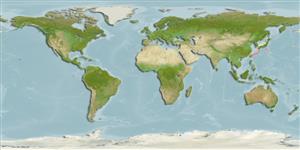Common names from other countries
>
Eupercaria/misc (Various families in series Eupercaria) >
Labridae (Wrasses) > Bodianinae
Etymology: Bodianus: Bodianus after Bodiano or Pudiano, from the Portuguese pudor, meaning modesty (Jordan & Evermann, 1896).; thoracotaeniatus: Name from the combination of the masculine Greek noun 'thorakos' for breastplate, and
feminine Latin noun for ribbon, refers to its diagnostic filamentously prolonged pelvic-fin ray..
Environment: milieu / climate zone / depth range / distribution range
Ökologie
seewasser riff-verbunden; tiefenbereich 320 - 395 m (Ref. 75973). Temperate
Northwest Pacific: Kyushu-Palau Ridge.
Size / Gewicht / Alter
Maturity: Lm ? range ? - ? cm
Max length : 14.8 cm SL Männchen/unbestimmt; (Ref. 75973)
Rückenflossenstacheln (insgesamt) : 12; Rückenflossenweichstrahlen (insgesamt) : 11. Distinguished morphologically by the following: D XII, 11; caudal fin rays 10 + 12 + 7-9; pectoral-fin rays ii, 15; lateral-line scales 29; scales above lateral line 2½; scales below lateral line 8-10; predorsal scales about 21-24; total gill rakers 15-16; anterior canines of similar size on upper jaw; dental ridge with 7-12 smaller posterior canines to anterior ones, last few sometimes smaller, coalesced at base and set apart from others; prominent canine at posterior end of jaw; lower jaw with first prominent anterior canine ?4?5 length of second; dental ridge with 2-3 consecutive series of smaller canines, first of 6-10 teeth, second with about 6-10 much smaller teeth sometimes separable into 2 groups, teeth confluent at base with acute tips; moderately deep body, 24.1-27.1% SL; moderately long snout (10.9-11.7% SL) and head (36.3-37.5% SL); pelvic fin with first soft ray faintly thicker and prolonged as filament, with tip reaching distinctly beyond anus, to base of third anal-fin ray in some (Ref. 75973).
Oviparous, distinct pairing during breeding (Ref. 205).
Life cycle and mating behavior
Maturities | Fortpflanzung | Spawnings | Egg(s) | Fecundities | Larven
Oviparous, distinct pairing during breeding (Ref. 205).
Gomon, M.F., 2006. A revision of the labrid fish genus Bodianus with descriptions of eight new species. Rec. Aust. Mus. Suppl. 30:1-133. (Ref. 75973)
IUCN Rote Liste Status (Ref. 130435)
CITES (Ref. 128078)
Not Evaluated
Bedrohung für Menschen
Harmless
Nutzung durch Menschen
Tools
Zusatzinformationen
Download XML
Internet Quellen
Estimates based on models
Preferred temperature (Ref.
115969): 3.5 - 5, mean 4.3 (based on 26 cells).
Phylogenetic diversity index (Ref.
82804): PD
50 = 0.5000 [Uniqueness, from 0.5 = low to 2.0 = high].
Bayesian length-weight: a=0.01202 (0.00551 - 0.02625), b=3.05 (2.87 - 3.23), in cm Total Length, based on LWR estimates for this Genus-body shape (Ref.
93245).
Trophic level (Ref.
69278): 3.4 ±0.5 se; based on size and trophs of closest relatives
Widerstandsfähigkeit (Ref.
120179): hoch, Verdopplung der Population dauert weniger als 15 Monate. (Preliminary K or Fecundity.).
Fishing Vulnerability (Ref.
59153): Low vulnerability (10 of 100).
